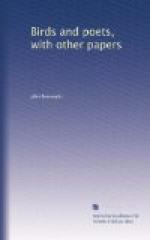The most melodious of our songsters, the wood thrush and the hermit thrush,—birds whose strains, more than any others, express harmony and serenity,—have not yet, that I am aware, had reared to them their merited poetic monument, unless, indeed, Whitman has done this service for the hermit thrush in his “President Lincoln’s Burial Hymn.” Here the threnody is blent of three chords, the blossoming lilac, the evening star, and the hermit thrush, the latter playing the most prominent part throughout the composition. It is the exalting and spiritual utterance of the “solitary singer” that calms and consoles the poet when the powerful shock of the President’s assassination comes upon him, and he flees from the stifling atmosphere and offensive lights and conversation of the house,—
“Forth to hiding, receiving night that talks not, Down to the shores of the water, the path by the swamp in the dimness, To the solemn shadowy cedars and ghostly pines so still.”
Numerous others of our birds would seem to challenge attention by their calls and notes. There is the Maryland yellowthroat, for instance, standing in the door of his bushy tent, and calling out as you approach, "which way, sir! which way, sir!" If he says this to the ear of common folk, what would he not say to the poet? One of the peewees says "stay there!" with great emphasis. The cardinal grosbeak calls out "what cheer” “what cheer;"” the bluebird says "purity,” “purity,” “purity;"_ the brown thrasher, or ferruginous thrush, according to Thoreau, calls out to the farmer planting his corn, "drop it,” “drop it,” “cover it up,” “cover it up" The yellow-breasted chat says "who,” “who" and "tea-boy" What the robin says, caroling that simple strain from the top of the tall maple, or the crow with his hardy haw-haw, or the pedestrain meadowlark sounding his piercing and long-drawn note in the spring meadows, the poets ought to be able to tell us. I only know the birds all have a language which is very expressive, and which is easily translatable into the human tongue.
II TOUCHES OF NATURE
I
WHEREVER Nature has commissioned one creature to prey upon another, she has preserved the balance by forewarning that other creature of what she has done. Nature says to the cat, “Catch the mouse,” and she equips her for that purpose; but on the selfsame day she says to the mouse, “Be wary,—the cat is watching for you.” Nature takes care that none of her creatures have smooth sailing, the whole voyage at least. Why has she not made the mosquito noiseless and its bite itchless? Simply because in that case the odds would be too greatly in its favor. She has taken especial pains to enable the owl to fly softly and silently, because the creatures it preys upon are small and wary, and never venture far from their holes. She has not shown the same caution in the case of the crow, because the crow feeds on dead flesh, or on grubs and beetles, or fruit and grain, that do not need to be approached stealthily. The big fish love to cat up the little fish, and the little fish know it, and, on the very day they are hatched, seek shallow water, and put little sandbars between themselves and their too loving parents.




